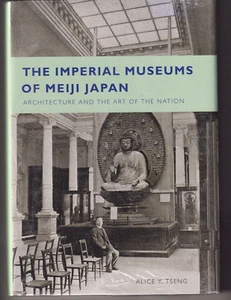Picture 1 of 2


Gallery
Picture 1 of 2


Have one to sell?
THE IMPERIAL MUSEUMS OF MEIJI JAPAN: By ALICE Y. TSENG (2008 HC){W1}
US $25.00
ApproximatelyS$ 32.22
Condition:
Brand New
A new, unread, unused book in perfect condition with no missing or damaged pages.
Oops! Looks like we're having trouble connecting to our server.
Refresh your browser window to try again.
Shipping:
Free USPS Media MailTM.
Located in: Oakville, Connecticut, United States
Delivery:
Estimated between Wed, 8 Oct and Tue, 14 Oct to 94104
Returns:
No returns accepted.
Coverage:
Read item description or contact seller for details. See all detailsSee all details on coverage
(Not eligible for eBay purchase protection programmes)
Shop with confidence
Seller assumes all responsibility for this listing.
eBay item number:266548845585
Item specifics
- Condition
- Brand New: A new, unread, unused book in perfect condition with no missing or damaged pages. See all condition definitionsopens in a new window or tab
- Features
- Dust Jacket
- Subject
- Architecture
- ISBN
- 9780295987774
About this product
Product Identifiers
Publisher
University of Washington Press
ISBN-10
0295987774
ISBN-13
9780295987774
eBay Product ID (ePID)
64160115
Product Key Features
Number of Pages
304 Pages
Language
English
Publication Name
Imperial Museums of Meiji Japan : Architecture and the Art of the Nation
Publication Year
2008
Subject
Asia / Japan, Ethnic Studies / Asian American Studies, Buildings / Religious, General, Regional
Type
Textbook
Subject Area
Architecture, Social Science, History
Format
Hardcover
Dimensions
Item Height
1 in
Item Weight
39.3 Oz
Item Length
10.3 in
Item Width
7.4 in
Additional Product Features
Intended Audience
Scholarly & Professional
LCCN
2007-044713
TitleLeading
The
Reviews
"A rigorous, closely argued yet broad-reaching analysis of the formation of Japan's three national museums in Tokyo, Kyoto, and Nara. By clearly demonstrating how and why Japanese museums, no less than their European and American counterparts, used transnational styles to express national ideals, the author situates Japan squarely within international cultural discourses of power, empire, and political legitimation." Christine Guth, Royal College of Art and Victoria and Albert Museum, London
Dewey Edition
22
Grade From
College Graduate Student
Illustrated
Yes
Dewey Decimal
727/.70952
Table Of Content
Acknowledgments Introduction 1. Encounters and Translations: The Origins of Hakubutsukan and Bijutsu 2. The Museum in Ueno Park: Styling the Nation 3. The Age of the Imperial Museum 4. The Imperial Kyoto Museum: Locating the Past within the Present 5. The Imperial Nara Museum: Administering History and Religion 6. The Hyokeikan Art Museum: Debating the Permanent Place of Art Conclusion Appendix Notes Glossary Bibliography Index
Synopsis
The story of the art and architecture of Japan's Imperial Museums, emphasizing design and construction influences from Europe and the United States, It was not until Japan's opening to the West during the Meiji period (1868-1912) that terms for "art" (bijutsu) and "art museum" (bijutsukan) were coined. The Imperial Museums of Meiji Japan documents Japan's unification of national art and cultural resources to forge a modern identity influenced by European museum and exhibition culture. Japan's Imperial Museums were conceived of as national self-representations, and their creation epitomized the Meiji bureaucracy's mission to engage in the international standards and practices of the late nineteenth century. The architecture of the museums, by incorporating Western design elements and construction methods, effectively safeguarded and set off the nation's unique art historical lineage. Western paradigms and expertise, coupled with Japanese resolve and ingenuity, steered the course of the museums' development. Expeditions by high-ranking Japanese officials to Europe and the United States to explore the burgeoning world of art preservation and exhibition, and throughout Japan to inventory important cultural treasures, led to the establishment of the Imperial Museums in the successive imperial cities of Nara, Kyoto, and Tokyo. Over the course of nearly four decades, the English architect Josiah Conder, known as "the father of modern Japanese architecture," and his student Katayama Tokuma, who became the preeminent state architect, designed four main museum buildings to house the national art collection. These buildings articulated the museums' unified mission to preserve and showcase a millennium-long chronology of Japanese art, while reinforcing the distinctive historical and cultural character of their respective cities. This book is the first English-language study of the art, history, and architecture of Japan's Imperial Museums, the predecessors of today's national museums in Tokyo, Kyoto, and Nara. The Imperial Museums of Meiji Japan examines the museums' formative period and highlights cross-cultural influences that enriched and complicated Japan's search for a modern yet historically grounded identity.
LC Classification Number
NA6690.T74 2008
Item description from the seller
Seller feedback (11,112)
- o***e (427)- Feedback left by buyer.Past monthVerified purchaseItem as described, packed well, shipped quickly, thanks!!
- Automatische feedback van eBay- Feedback left by buyer.Past monthBestelling op tijd geleverd zonder problemen
- c***c (325)- Feedback left by buyer.Past monthVerified purchaseFast shipping. Thank you

